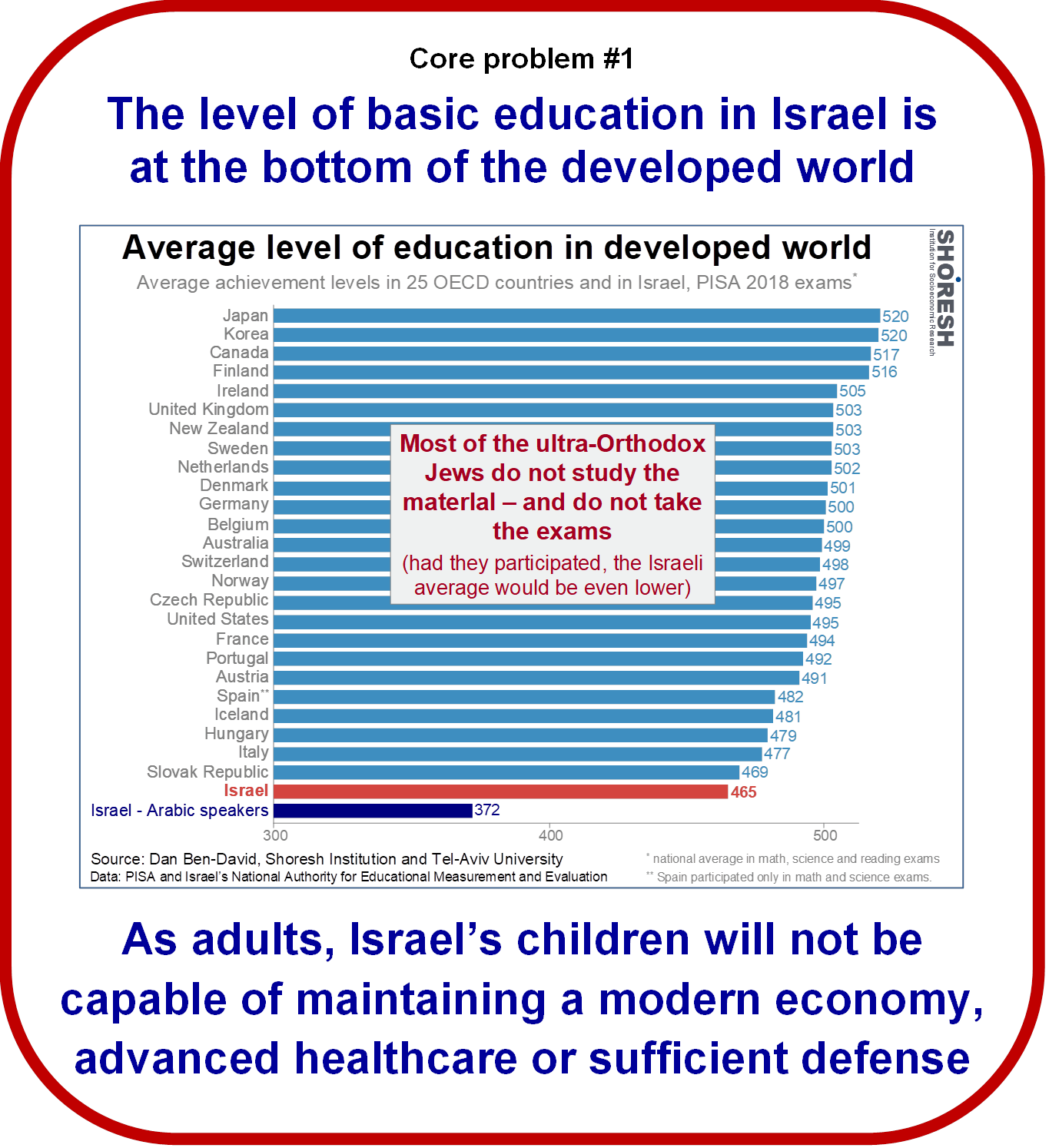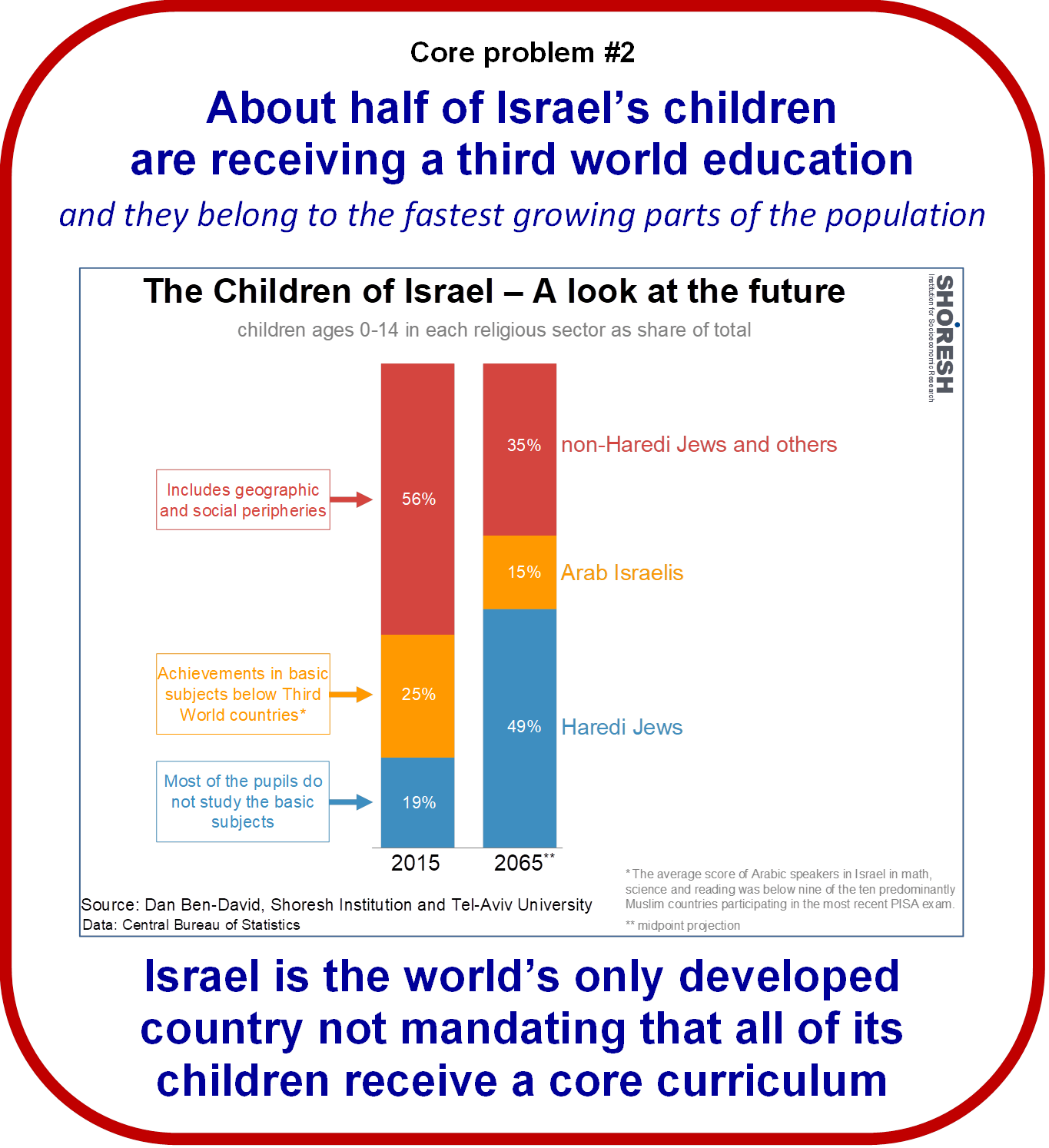|
published
in Times of Israel on March 16, 2021. Israel’s elections and the three core domestic problems that need to top the agenda by Dan Ben-David There
is an abundance of the socioeconomic issues requiring Israel’s attention, but
there are three specific challenges that literally endanger the country’s
future if not fully addressed soon. Covid-19 raised to
the surface a host of problems that Israel has swept under the rug for years.
The good news – if one could even refer to them in this way – is that the
pandemic provided an early warning of a future that will endanger Israel’s very
existence. The upcoming elections provide us with one of our last viable
opportunities for a major pivot in Israel’s national priorities before the
current future trajectory becomes irreversible. Daily
torrents of data pouring from storms of spins and alternative facts diminish
the ability to distinguish between wheat and chaff. In the actual world, the
one behind the veil of partial and misleading information, Israel has been
steadily falling further and further behind (in relative terms) the developed
world’s leaders since the 1970s. The
gap in GDP per hour worked (which determines whether a high hourly wage can be
given) between the average of the G7 countries (USA, Canada, England, France,
Germany, Italy and Japan) and Israel has more than tripled over the past four
and a half decades. 
There
are many reasons why Israel has been falling behind. But with the upcoming
elections around the corner, it is important to focus the public discourse on
Israel’s three primary socioeconomic problems. If we fail to deal with them
thoroughly and decisively while we still can, there will be no future Israel
for our grandchildren. Period. First
of all, the educational system’s complete dysfunction during the coronavirus
year just highlights its perennial dysfunction, which has been methodically
destroying Israel’s future for decades. 
Secondly,
a small – for the time being – haredi (ultra-Orthodox) leadership is doing
anything and everything to maintain power.
It is (1) enabled by the government to completely control the flow and
content of all information reaching its people from birth, and (2) advocating
policies that literally endangered the lives of its own community (not to
mention the rest of the country) during the deadliest pandemic in a
century. One can only imagine Israel’s
future when taking into account the exponential speed of the country’s
demographic changes. 
Lastly,
selective law enforcement has exacerbated far more than the corona crisis. For
years, this conduct has been distorting the tax burden and creating huge losses
in tax revenues. As if this were not enough, the lack of budget transparency
has enabled sectoral and personal considerations to override national ones in
determining the government’s distribution of our tax money. 
Choices
determining Israel’s future will be made soon, whether by conscious decisions
or by the current default. The three
most crucial challenges requiring immediate and systemic solutions highlighted
above are not yet a factor in the upcoming elections (the Shoresh Institution
website provides a considerably wider perspective of Israel’s core
socioeconomic challenges). That needs to
change. A
country desiring continued existence needs to know when to set aside the
Left-Right, religious-secular, Jewish-Arab agendas because we are all on the
same ship. The time has long since passed for us to stop quibbling over the
arrangement of deck chairs on the Titanic. There
is a huge iceberg in front of us all. If
we do not come to our senses and change course while we still can – before
eclipsing Israel’s demographic-democratic point of no return, after which laws
that are already difficult to pass in the Knesset will become impossible to
legislate – that iceberg will spell the end of Israel. The
graph below partitions the world into three main income groups: rich, medium
income and poor countries. Fertility rates in the wealthy countries are low –
and in some cases, even too low for maintaining adequate social security and
welfare systems. In the middle-income group there are countries with relatively
high fertility rates. The group of poor countries is huge – roughly four times
the size of each of the other two groups – and their fertility rates are high. 
Israel
is not a member of any group – that is, Israel is not at a steady-state
long-term equilibrium. In a sense, we’re the developed world’s “plus one,” with
a per capita income that places Israel at the bottom of the first world
economically, with third world fertility rates. In
fact, if you draw a straight line from the United States through Israel, you
reach Burundi, the poorest country in the graph. Israel is a sort of weighted
average of the two countries, with one foot in the first world and the other
foot planted firmly in the third world. Alongside the start-up nation, with its
world-class universities and amazing cutting-edge high-tech sector, there is
another nation within Israel – a population group that receive neither the
tools nor the conditions to work in a competitive global economy and live in a
modern society. Already
today, half of Israel’s population is so poor that it does not reach the lowest
income tax threshold and does not pay any income tax at all. The top two income
deciles alone, just 20% of the population – mainly Israel’s more educated and
skilled persons, the ones with alternatives abroad – account for 92% of all
Israel’s total income tax revenue, with the gross income per earner in the
ninth decile averaging only NIS 18,800 per month ($68,300 annually). The burden
on these shoulders has been rising steadily over the years (it stood at 82% of
all income tax revenue twenty years ago). This is not a process that can
continue unabated forever. When
merged together, the very poor education provided in Israel (core problem 1),
the exponential pace of demographic change (core problem 2) and the
inability/unwillingness to enforce laws and implement budget transparency (core
problem 3), should leave no doubt as to which of the three groups in the last
graph – first world, medium income or third world – Israel is currently headed
toward. So
what should we do between now until Election Day? 1.
Make sure
that all of the candidates understand and internalize the three core problems.
If each reader sends a link of this article to five of their friends, and each
of them does the same with five of their friends, we can ensure that the
information will be seen and will hopefully enter into the voting
considerations. 2.
Require
candidates to outline their vision for Israel in 20 years’ time: (a) What kind
of a country do they want here? (b) Can such a country exist in a modern and
competitive world? (c) Does what they describe sound logical and sustainable
over time? (d) How do they intend to provide core treatment for the core
problems? and (e) Are they able to provide a serious roadmap for Israel to
adopt for implementing their vision and getting us from here to there? Israel’s
“everything will be okay” mindset is its Achilles heel. Nothing will be ok if
we don’t get our act together, rebuild the broken systems from their core and
see to it that we leave a future here for our children and grandchildren. “If
you will it, there’s a way!” These words of Theodore Herzl spurred our founding
fathers to build a country here against all odds. They also signal that it’s
within our power to save our country when everything may seem hopeless. This
time, it’s on us. |